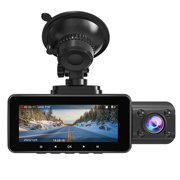Animals usually have erratic and unpredictable behavior that can put drivers and themselves in dangerous situations. Animal-vehicle collisions can happen abruptly, especially in low-light conditions when drivers can't see the road ahead clearly. Such accidents not only cause harm and injury to the driver and his passengers, but also to the animal that the car collided with.
1. Recorded Data of Animal-Vehicle Collision
In the previous years, animal-car accidents per year were roughly calculated at one million, with about 200 deaths, 29,000 injuries and loss of $1 billion in property.
There are reports in 2004, where 26,000 animal-vehicle related injuries were recorded. Fifty percent of these cases resulted from hitting the animals, while the other fifty percent came from the desire to save the animals - by swerving the car to the left or right.
Not every accident has been reported to the authorities, when it happens. However, according to the latest federal highway report, there are about 250,000 cases of animal-car crashes that occur every year.
2. Facts About Animal-Vehicle Collision
The following are some fast facts that each of us should know, as they are known to be true.
- There is an increasing number of animal-vehicle collisions and this is associated with many factors, including increase in deer population in most regions in the US and increase in VMT (vehicles miles traveled). The biggest contributor to these accidents, especially at night, is speed. Over speed makes the driver unable to slow down and stop, when an animal suddenly appears on the roadway.
- Deer is most involved in animal-vehicle collisions. They comprise about 80 percent, while the remaining 20 percent include other wildlife, such as moose, elk, coyote and bears.
- Animal-vehicle collision can happen, regardless of the season, but it is during the fall that most accidents happen. This is a mating as well as the hunting season and deer are most active during this time, so they tend to travel aimlessly beyond their normal area.
- The peek hours for the animals to roam the road are between sunset and midnight; as well as in the morning, before and after the sun rises. Remember, these are high risk times that are highest for animals having a collision with vehicles.
- Deer and other big animals do not often cross the road alone. If you see one deer while you drive, expect that there are several others nearby.
- When you collide with an animal and you see it has been hurt, avoid getting out of your car to look at it or touch it. Animals, when they get wounded or frightened, may hurt you. Stay inside your vehicle and call the authorities.

3. Tips to Do to Avoid Animal-Vehicle Collisions
- Be cautious at dusk and dawn
Making sure that you avoid potential harm or mishap. These are risky times because visibility is comparatively less and these are times for animals to go out and do their things. Don't forget that the vision of animals is very different from that of humans. The deer can see well in low light environment, but they can be blinded by headlights.
- Have a perception of your surroundings
If you see a deer in areas near water and woods., it is most likely that there are more, so don't relax yet. Observe the speed limits that you see posted on the road, and ensure to reduce your speed, especially when you're driving at night.
- Install a Night Vision System to your car
There are many such products in the market, but the most innovative is the Lanmodo Vast Pro Automotive Night Vision System. It is a safe driving assistant that uses NIR (Near Infrared) technology. With a night view distance of about 300 meters, you can see animals on the road before your headlights reach it. The Lanmodo Vast Pro can provide a 1080p, full color image and a 45 degree angle vision. You can use this sensor when you are driving, especially at night, so you get a very clear image of what's ahead and take the necessary precautions to prevent a collision.

- Watch for warning signs while you drive
Signs are usually posted in areas where there are a lot of animals or in accident prone zones. Never ignore these signs, watch your speed and be super alert. Have a calm demanor, when you see a deer or any animal on the road. Do not swerve the wheels because you could hit another car or a tree and you may find yourself in a situation that's even more dangerous than you were before. When no other vehicles follow you closely, hit the brakes, blow the horn and make skillful and careful series of moves.



